2017 PEUGEOT PARTNER TEPEE ELECTRIC ignition
[x] Cancel search: ignitionPage 5 of 252
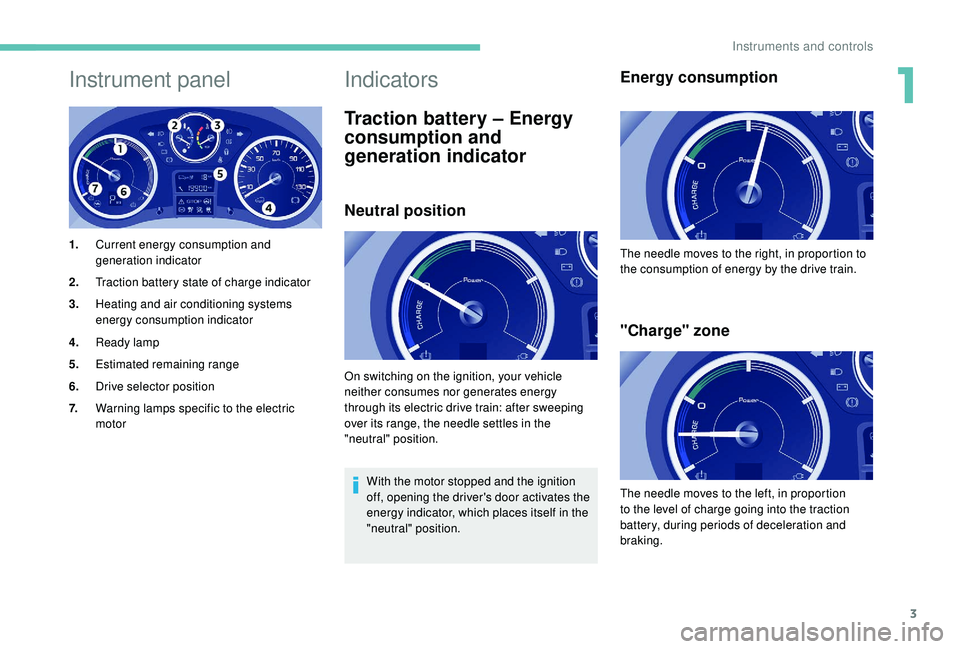
3
Instrument panel
1.Current energy consumption and
generation indicator
2. Traction battery state of charge indicator
3. Heating and air conditioning systems
energy consumption indicator
4. Ready lamp
5. Estimated remaining range
6. Drive selector position
7. Warning lamps specific to the electric
motor
Indicators
Traction battery – Energy
consumption and
generation indicator
Neutral position
With the motor stopped and the ignition
off, opening the driver's door activates the
energy indicator, which places itself in the
"neutral" position.
Energy consumption
"Charge" zone
On switching on the ignition, your vehicle
neither consumes nor generates energy
through its electric drive train: after sweeping
over its range, the needle settles in the
"neutral" position. The needle moves to the right, in proportion to
the consumption of energy by the drive train.
The needle moves to the left, in proportion
to the level of charge going into the traction
battery, during periods of deceleration and
braking.
1
Instruments and controls
Page 6 of 252
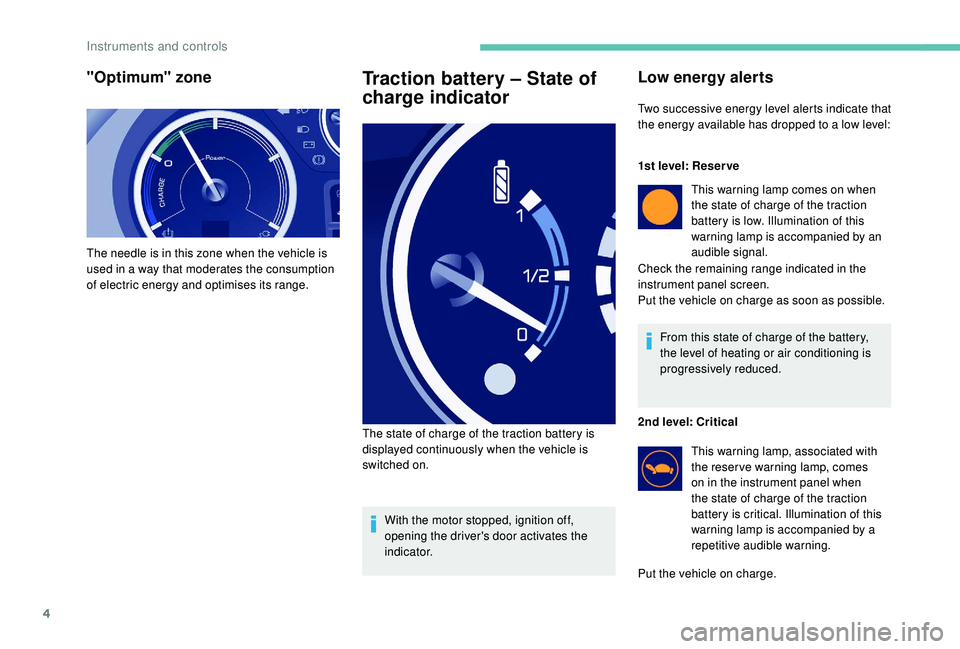
4
"Optimum" zone
The needle is in this zone when the vehicle is
used in a way that moderates the consumption
of electric energy and optimises its range.
Traction battery – State of
charge indicator
With the motor stopped, ignition off,
opening the driver's door activates the
i n d i c a t o r.
The state of charge of the traction battery is
displayed continuously when the vehicle is
switched on.
Low energy alerts
Two successive energy level alerts indicate that
the energy available has dropped to a low level:
1st level: Reser ve
This warning lamp comes on when
the state of charge of the traction
battery is low. Illumination of this
warning lamp is accompanied by an
audible signal.
Check the remaining range indicated in the
instrument panel screen.
Put the vehicle on charge as soon as possible.
From this state of charge of the battery,
the level of heating or air conditioning is
progressively reduced.
2nd level: Critical This warning lamp, associated with
the reser ve warning lamp, comes
on in the instrument panel when
the state of charge of the traction
battery is critical. Illumination of this
warning lamp is accompanied by a
repetitive audible warning.
Put the vehicle on charge.
Instruments and controls
Page 10 of 252

8
Starting procedure
Starting the vehicle
- To start the vehicle, the drive selector must be in position P ,
-
p
ress the brake pedal,
-
t
urn the ignition key in the
switch.
Ready
This indicator lamp comes on when
the vehicle is ready to drive.
-
P
ress the brake pedal,
-
select R or D,
-
r
elease the brake pedal and press the
accelerator pedal to move off.
Instrument panel
The screen shows:
- a t rip distance recorder (choice of trip 1 or 2),
-
t
he average energy consumption from the
battery (over 62
miles (100 km)),
-
T
he average speed since the start of the
trip. This screen displays an estimated driving
range in miles or kilometres before the battery
has to be charged.
Trips (1 and 2)
Instruments and controls
Page 11 of 252

9
Parking the vehicle
When leaving the vehicle, it is strongly
recommended that you apply the parking
brake, place the drive selector in position P,
then switch off the ignition.
There is an audible signal on opening the
driver's door if:
-
t
he ignition is still on (" Ready" lamp on),
-
t
he vehicle has not been correctly
immobilised (drive selector not in
position P ).
An alert message is displayed in the screen.
Drive selector
P (Park). Parking. Move the selector
to position P , an audible signal will
sound.
If the drive selector is not in position P and/or if
the brake pedal is not pressed, the vehicle will
not start. Repeat the procedure for starting the
vehicle.
Selecting position D or R on the selector
determines the driving direction. It is preferable
to be at a complete stop before changing the
drive direction. The selection appears in the current energy
consumption screen in the instrument panel.
The driver must be particularly vigilant
when driving the electric vehicle as it
makes very little noise when moving. N (Neutral). Neutral. Move the
selector to position N , an audible
signal will sound.
Do not select this position, even momentarily,
when the vehicle is moving.
The vehicle is free-wheeling. Select D to return
to for ward drive. D (Drive). For ward drive. Move the
selector to position D , an audible
signal will sound. It is recommended to keep the brake pedal
pressed down to select positions R or D
.
R (Reverse). Reverse. Move the
selector to position R , an audible
signal will sound.
Only engage reverse when the vehicle is
immobilised.
When moving from position R to position P , N is
displayed momentarily in the instrument panel.
There is an audible signal when changing
drive position with the selector.
The audible signal is deactivated if the user has
chosen to inhibit operation of the "Rear parking
sensors".
1
Instruments and controls
Page 22 of 252
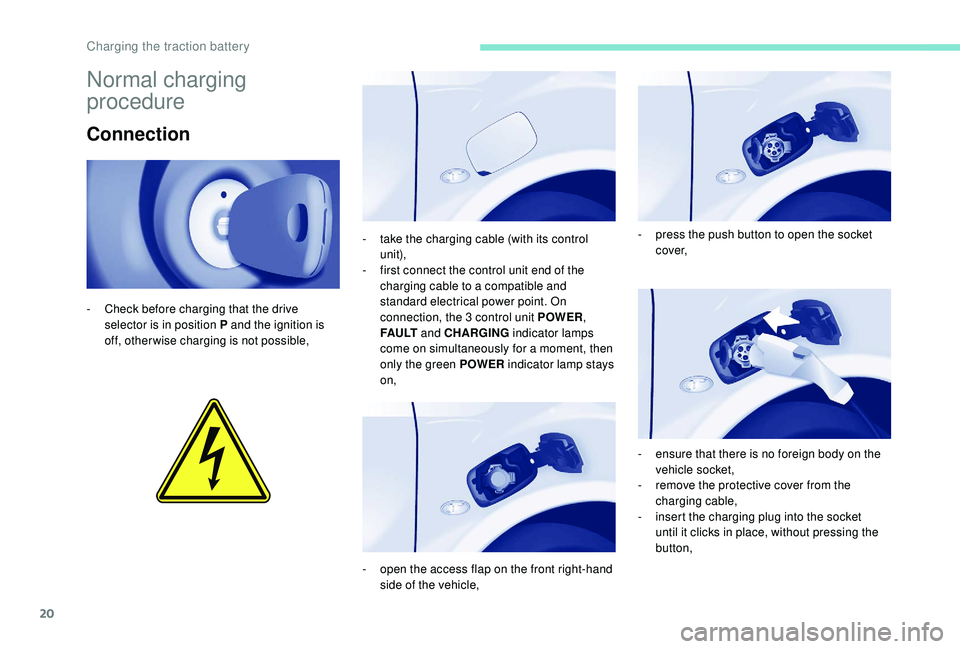
20
Normal charging
procedure
Connection
- Check before charging that the drive selector is in position P and the ignition is
off, other wise charging is not possible, -
t
ake the charging cable (with its control
unit),
-
f
irst connect the control unit end of the
charging cable to a compatible and
standard electrical power point. On
connection, the 3 control unit POWER,
FA U LT and CHARGING indicator lamps
come on simultaneously for a moment, then
only the green POWER indicator lamp stays
on,
-
o
pen the access flap on the front right-hand
side of the vehicle, -
p
ress the push button to open the socket
c ove r,
-
e
nsure that there is no foreign body on the
vehicle socket,
-
r
emove the protective cover from the
charging cable,
-
i
nsert the charging plug into the socket
until it clicks in place, without pressing the
button,
Charging the traction battery
Page 24 of 252
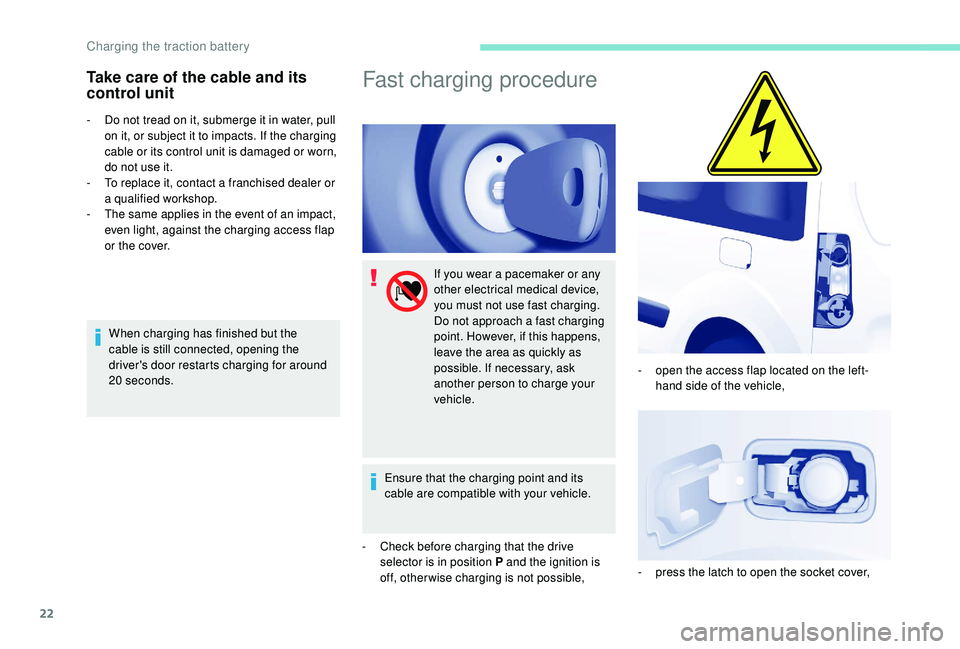
22
Take care of the cable and its
control unit
- Do not tread on it, submerge it in water, pull on it, or subject it to impacts. If the charging
cable or its control unit is damaged or worn,
do not use it.
-
T
o replace it, contact a franchised dealer or
a qualified workshop.
-
T
he same applies in the event of an impact,
even light, against the charging access flap
or the cover.
When charging has finished but the
cable is still connected, opening the
driver's door restarts charging for around
20
seconds.
Fast charging procedure
If you wear a pacemaker or any
other electrical medical device,
you must not use fast charging.
Do not approach a fast charging
point. However, if this happens,
leave the area as quickly as
possible. If necessary, ask
another person to charge your
vehicle.
Ensure that the charging point and its
cable are compatible with your vehicle.
-
C
heck before charging that the drive
selector is in position P and the ignition is
off, other wise charging is not possible, -
o
pen the access flap located on the left-
hand side of the vehicle,
-
p
ress the latch to open the socket cover,
Charging the traction battery
Page 26 of 252
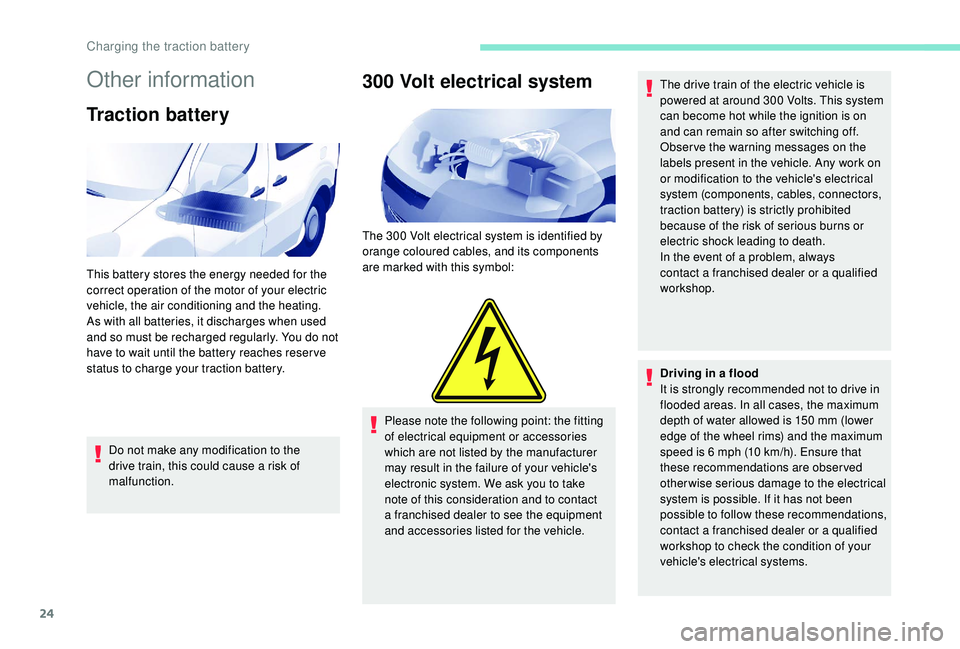
24
Other information
Traction battery
Do not make any modification to the
drive train, this could cause a risk of
malfunction.
300 Volt electrical system
The 300 Volt electrical system is identified by
o range coloured cables, and its components
are marked with this symbol:
Please note the following point: the fitting
of electrical equipment or accessories
which are not listed by the manufacturer
may result in the failure of your vehicle's
electronic system. We ask you to take
note of this consideration and to contact
a franchised dealer to see the equipment
and accessories listed for the vehicle. The drive train of the electric vehicle is
powered at around 300
Volts. This system
can become hot while the ignition is on
and can remain so after switching off.
Obser ve the warning messages on the
labels present in the vehicle. Any work on
or modification to the vehicle's electrical
system (components, cables, connectors,
traction battery) is strictly prohibited
because of the risk of serious burns or
electric shock leading to death.
In the event of a problem, always
contact a franchised dealer or a qualified
workshop.
Driving in a flood
It is strongly recommended not to drive in
flooded areas. In all cases, the maximum
depth of water allowed is 150
mm (lower
edge of the wheel rims) and the maximum
speed is 6
mph (10 km/h). Ensure that
these recommendations are observed
otherwise serious damage to the electrical
system is possible. If it has not been
possible to follow these recommendations,
contact a franchised dealer or a qualified
workshop to check the condition of your
vehicle's electrical systems.
This battery stores the energy needed for the
correct operation of the motor of your electric
vehicle, the air conditioning and the heating.
As with all batteries, it discharges when used
and so must be recharged regularly. You do not
have to wait until the battery reaches reser ve
status to charge your traction battery.
Charging the traction battery
Page 29 of 252
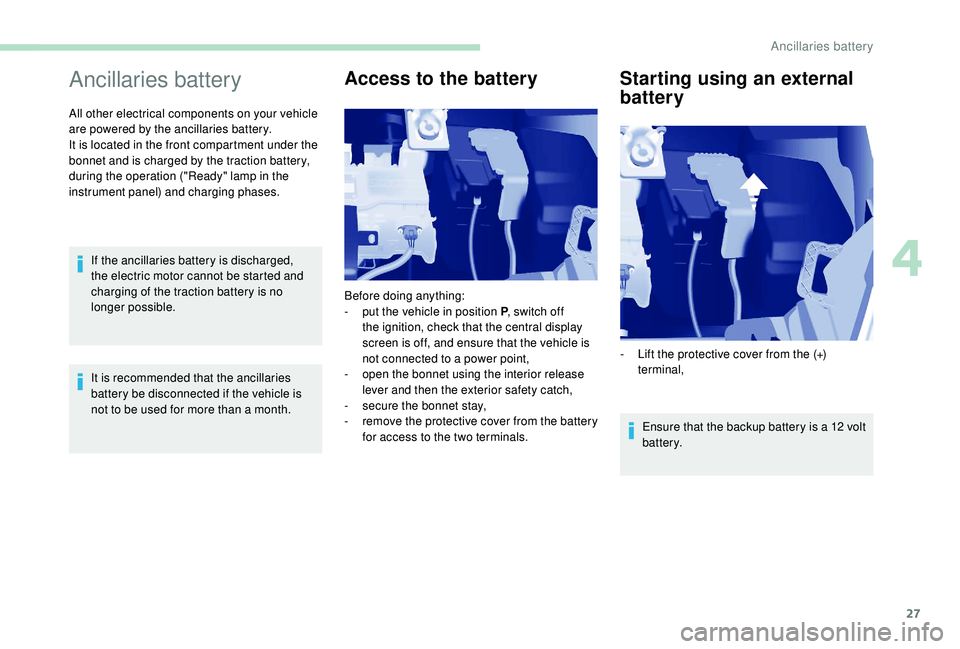
27
Ancillaries battery
All other electrical components on your vehicle
are powered by the ancillaries battery.
It is located in the front compartment under the
bonnet and is charged by the traction battery,
during the operation ("Ready" lamp in the
instrument panel) and charging phases.If the ancillaries battery is discharged,
the electric motor cannot be started and
charging of the traction battery is no
longer possible.
It is recommended that the ancillaries
battery be disconnected if the vehicle is
not to be used for more than a month.
Access to the battery Starting using an external battery
Ensure that the backup battery is a 12 volt
b attery.
Before doing anything:
-
p
ut the vehicle in position P
, switch off
the ignition, check that the central display
screen is off, and ensure that the vehicle is
not connected to a power point,
-
o
pen the bonnet using the interior release
lever and then the exterior safety catch,
-
s
ecure the bonnet stay,
-
r
emove the protective cover from the battery
for access to the two terminals. -
L
ift the protective cover from the (+)
terminal,
4
Ancillaries battery